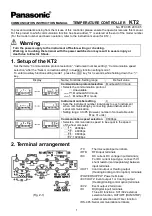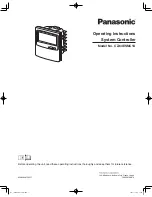
142
Rockwell Automation Publication ICSTT-RM447M-EN-P - July 2019
Chapter 9
System Build
Assemblies of Base Units
When base units are installed adjacent to each other they are physically
connected by mating connectors and retaining clips so all of the unit forms a
single mechanical assembly. Once the base units and termination assemblies
have been installed, the insertion and removal of modules will not disturb
other electrical connections.
Base Units Rows and
Expansion Cables
AADvance 9300 I/O base units connect to the right hand side of the 9100
processor base unit (I/O Bus 1) and to the right hand side of other 9300 I/O
base units by a direct plug and socket connection. The I/O base units connect
to the left hand side of the processor base unit by using the 93100 expansion
cable (I/O Bus 2). The expansion cable also connects the right hand side of I/
O base units to the left hand side of other I/O base units to install extra rows of
I/O base units. Base units are secured in place by top and bottom clips that are
inserted into the slots on each base unit.
CAUTION: HEAT DISSIPATION AND ENCLOSURE POSITION
The maximum air temperature rating in an enclosure where standard
AADvance processor and I/O modules are installed to maintain predictable
reliability is 70 ºC (158 °F) for I/O modules and 60 °C (140 °F) for processor
modules. System and field power consumption by modules and termination
assemblies is dissipated as heat. You should consider the effect of heat
dissipation on the design and positioning of your enclosure; e.g. enclosures
exposed to continuous sunlight will have a higher internal temperature that
could increase the operating temperature of the modules. Modules operating
at the extremes of the temperature band for a continuous period can have a
reduced reliability.
ATTENTION:
DISSIPATION THERMIQUE ET EMPLACEMENT DE L’ENCEINTE
La température ambiante nominale maximum dans une enceinte où un
processeur AADvance et des modules d’E/S standard sont installés pour
assurer une fiabilité prévisible, est de 70 ºC (158 °F) pour modules d’E/S et de
60 °C (140 °F) pour processeur. La consommation électrique du système et
du terrain par les modules et les ensembles de raccordement est dissipée
sous forme de chaleur. Vous devez tenir compte de l’effet de la dissipation
thermique lors de conception et de disposition de votre enceinte, par
exemple, des enceintes continuellement exposées à la lumière solaire auront
une température interne plus élévée qui pourrait accroître la température de
fonctionnement des modules. La fiabilité des modules fonctionnant aux
limites extrêmes de la plage de température pendant une période prolongée
peut être réduite.
Содержание Allen-Bradley AADvance T9110
Страница 4: ...4 Rockwell Automation Publication ICSTT RM447M EN P July 2019 ...
Страница 6: ...6 Rockwell Automation Publication ICSTT RM447M EN P July 2019 Summary of Changes ...
Страница 10: ...10 Rockwell Automation Publication ICSTT RM447M EN P July 2019 Preface ...
Страница 16: ...16 Rockwell Automation Publication ICSTT RM447M EN P July 2019 Table of Contents ...
Страница 18: ...18 Rockwell Automation Publication ICSTT RM447M EN P July 2019 Chapter 1 The AADvance System ...
Страница 52: ...52 Rockwell Automation Publication ICSTT RM447M EN P July 2019 Chapter 2 The AADvanceSafety Controller ...
Страница 96: ...96 Rockwell Automation Publication ICSTT RM447M EN P July 2019 Chapter 6 Specifying a New Controller ...
Страница 97: ...Rockwell Automation Publication ICSTT RM447M EN P July 2019 97 Specifying a New Controller Chapter 6 ...
Страница 98: ...98 Rockwell Automation Publication ICSTT RM447M EN P July 2019 Chapter 6 Specifying a New Controller ...
Страница 110: ...110 Rockwell Automation Publication ICSTT RM447M EN P July 2019 Chapter 6 Specifying a New Controller ...
Страница 138: ...138 Rockwell Automation Publication ICSTT RM447M EN P July 2019 Chapter 8 Application Resource Development ...
Страница 146: ...146 Rockwell Automation Publication ICSTT RM447M EN P July 2019 Chapter 9 System Build ...
















































